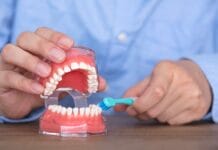Jaw sprain is a common event yet is commonly underreported or misdiagnosed. The jaw is one of the most used joints in the human body, and it makes sense for it to have wear and tear, overuse, injuries, and pain.
Dental patients who experience a jaw sprain have a challenging time keeping their mouths open and constantly need to rest it. They will tend to rub the cheek/TMJ area and move the mouth around to pop something in or out or to loosen and release a tight feeling. Or, dental patients may cup their chins and cheeks to stabilize their mouths during dental procedures.
Patient complaints of pain tend to be the same as after having root canal treatment, third molar extractions, an implant placed, or multiple restorations completed, all with the same denominator of being in a dental chair where pressure is applied during dental treatment. How many times have we heard exaggerated stories (or what it pretty much felt like) of dentists drastically putting their knees on the patients’ chests to pull a stubborn wisdom tooth, and the amount of applied pressure almost broke their jaw.
These occurrences associated with dental treatment are likely a sign of jaw strain or sprain.
The Jaw Never Rests
Other parts of the body can be sprained, too, such as the knee. The obvious thing to do would be to stay off the knee, give it some rest, ice/hot therapy, and avoid any unusual movements. In fact, with a knee, other body parts will compensate and pick up the slack.
While that sounds ideal, it is not reasonable for the jaw to have those accommodations. The whole jaw movement is a package. The operation of the jaw is bilateral as only one side is not optional to use. It is impossible to rest it for any amount of time as the jaw is used for eating, drinking, swallowing, talking, yawning, smiling, and, especially when under stress, it involuntarily grinds or clenches.
The jaw is a complex joint system. It contains the temporomandibular joint (TMJ), muscles, ligaments, and tendons that work together for optimal function. The jaw uses a variety of movements, including rotating, gliding, protruding, and retracting to simplify eating, speaking, and swallowing.
Jaw sprain can occur from hyperextending as in yawning, overextending by taking a big bite of food, playing a wind instrument with the jaw pushed forward, or by keeping the mouth opened for longer periods of times such as during dental treatments. These factors can cause direct trauma or strain to the ligaments, tendons, joints, and muscles.
JAMSS: Jaw and Muscle Strain/Sprain
JAMSS is the diagnostic term to describe an acute trauma to the jaw, characterized by sudden jaw pain, limited range of motion, tenderness, or dysfunction. It is a localized acute musculoskeletal disorder that occurs from a traumatic or mechanical injury. It can happen as acute obvious direct trauma such as a hit to the jaw, car accident, clenching, grinding, overuse, yawning, hard or sustained chewing, or intubation during a surgical procedure. An acute muscle strain occurs from intense contraction of the muscles.
In the dental operatory, lengthy dental procedures increase the risk of muscle strain and sprain. This is when muscle fibers promote pain from being stretched and put under undue stress. Damage to the muscle stimulates an involuntary pain reflex which causes the muscle to contract without control and causes loss of range of motion.1 The mouth starts to ache, and it feels like the muscles are trembling, making it challenging to keep the mouth open. Yet it’s excruciating to close it, keeping it caught in that precarious zone of strain. It’s comparable to exercising, and the legs become weak and shaky, and it’s hard to stand while it’s just as unsteady to walk.
Anatomy
A jaw strain or sprain affects different anatomy of the facial region.
TMJ: The TMJ is a unique type of joint known as a ginglymoarthrodial joint, with both hinge and sliding movements allowing the mouth to open and close and move side to side. It’s the connection of the mandible to the skull.
Masseter muscle: Known as the strongest muscle in the body, it attaches to the zygomatic arch and the ramus. This muscle elevates the jawbone to bring the teeth together and serve as a major stabilizer for the TMJ.2
Temporalis muscle: The muscle closes the mouth and assists the jaw in moving side to side to grind up the food.
Pterygoid muscles: They open and close the mandible, assisting in mastication by opening and closing the jaw.
Tendons: Band of tissue that attaches a muscle to a bone.
Ligaments: The tough bands of fibrous tissue that connect two bones together.
Trigeminal nerve: Innervates and controls the motor function of the masseter, medial and lateral pterygoid muscles and controls the temporalis. In addition, it’s responsible for sensation in the face and motor function with chewing and biting.3
Jaw Strain/Sprain from Dental Procedures
Dental procedures where the jaw opens for too long or too wide not only can cause a sprain or strain from prolonged stretching of the masticatory muscles, joints, ligaments, and tendons but also temporomandibular joint disorders. One reason some patients develop JAMSS from a long dental procedure is that the design of the joint allows for a patient to open too wide, and then the dental provider pushes it slightly further, resulting in the injury.
Anesthetic injections can cause jaw pain since these types of traumas tend to injure soft tissue structures, as with the direct trauma of the mandibular or lingual nerve, hematoma, or needle track abscesses. Local anesthetic injections can rupture the protective sheath surrounding the nerve fascicles, can protrude the connective tissue around the myelin sheath of a nerve fiber, and can cause transection of the multiple nerve fibers. It may also cause trauma to the intraneural blood vessels and promote bleeding and intraneural hematomas. Any of these conditions can cause jaw pain after dental procedures.4
Sprain vs. Strain
A sprain is the excessive stretching of ligaments. Jaw sprain occurs to the ligaments surrounding the jaw when they are stretched further than normal. The sprain of the ligament fibers varies from mild to severe, depending on the amount of ligaments torn.
A strain involves an injury to the muscle or tendons. Strains to the jaw occur due to the constraints and demands placed on the muscle fibers. If the muscles are unable to handle the stress, it can cause the muscle fibers to hyperactivate and to tear.5
The symptoms of a jaw sprain or strain include:
- Jaw popping and/or locking
- Limited range of movement
- Jaw tenderness
- Pain in the neck and/or TMJ
- Head or earache
- Muscle stiffness
- Joint function altered5
Additional symptoms can be elaborated on as follows:
Jaw spasm ─ Jaw spams happen when the muscles tighten and can’t relax because of damage to nerves. This may be caused by diseases, trauma, myofascial pain syndrome, TMJ disorder, medications from dental procedures (commonly an oral surgery type), or dental anesthetic injections into the inner cheek.6
Trismus ─ Trismus, commonly known as lockjaw, is a painful condition that restricts normal jaw movement and function from a result of masticatory muscle spasms. It causes a limited range of motion and disturbance of the trigeminal nerve. The causes are facial trauma, needle injections into the medial pterygoid muscle, radiation treatment, and prolonged mouth opening.7
Muscle guarding ─ Muscle guarding is the body’s own self-defense mechanism. In certain situations, muscles are put in a readiness state, preventing the muscles from relaxing and prolonging muscles to partially contract until a resolution occurs. Sustained or forceful contractions or hyperextension of the masticatory muscles causes muscle guarding. When pain is felt around the injured area, as when the jaw is opened too long or wide, the initial muscles are strained and fatigued; the supporting or opposing muscles are then forced to compensate for the injured muscle.8
In a 2016 article, the Journal of the American Dental Association (JADA) clarified the degrees of jaw muscle sprain/strain:
- First degree: Slight muscle or ligament strain and subclinical fiber tearing with mild pain and slight functional limitations.
- Second degree: Partial muscle or ligament tear with blood clot formation and bruising with moderate pain and moderate functional impairment of the muscle or ligament with visible morphologic change with severe pain and loss of function and stability.
- Third degree: Total separation of the muscle or ligament with severe pain and loss of function and stability.4
Some patients are more susceptible to this trauma. Orofacial Therapeutics, which manufactures the QuickSplint bite plane, offers helpful tips regarding risk assessments during dental procedures on its website.9
- Low risk in patients with no prior history of acute jaw pain or injury, normal range of motion of 40mm, procedure on the upper anterior, short procedures with topical anesthesia and infiltration and minimal pain expected after procedure.
- Medium risk in patients with prior history of acute jaw pain or injury, less than normal range of motion, procedure on the maxillary bilateral posterior or mandible anterior to first molar, long procedures with breaks and mandible analgesia infiltration, maxillary nerve block and procedure expected to cause mild to moderate pain without bleeding.
- High risk in patients with prior history of acute jaw pain or injury with signs of parafunctional habits, less than normal range of motion, bilateral procedure on the mandible/ maxillary molars, long procedures with breaks, multiple mandibular anesthetic injections, and moderate to severe pain expected with bleeding.10
Treatment
There are easy ways to recognize and treat the jaw. Pain may show up in the present moment, within hours or days. It is crucial to treat a sprain or strain as soon as possible, ideally within 30 days, so it doesn’t become chronic or intractable pain. If the pain does not subside within the normal few days after treatment, have the patient return for an evaluation.
If treated early, it can be resolved within four weeks, according to a JADA study. Patients who have pain that persists for longer than one month commonly report pain five years later.4 If pain is left untreated, neuroplasticity of the nervous system and the use of the agonist’s muscles can promote peripheral and central sensitization. Local tissues in the injured area become sensitive to a simple mechanical stimulation. When the pain increases to a chronic stage, an increased and more intense perceived tenderness and sensitivity can occur from just a normal touch and stimulation to cause debilitation.1
It is recommended that dental treatment consists of short appointments with breaks, employing limited use of bite blocks. An anti-inflammatory might be suggested prior to the appointment. Stop treatment if the patient is having trouble keeping the jaw open.
Dr. Brad Eli, a California dentist who specializes in treating TMJ pain, suggests taking a break every 30 minutes if the jaw will be opened 25mm to 35 mm; every 20 minutes if the jaw is opened 35 mm to 45mm; and every 10 minutes if opened more than 45mm.
After dental treatment, the following steps may be recommended:
- Medication: NSAIDS or aspirin as an anti-inflammatory and pain-reducing medication for short term use.
- Cold: When a strain happens in the muscles, fibers in the tissue are damaged to cause immediate pain, inflammation, and swelling. Apply cold on the tender area to reduce the inflammation as soon as possible.
- Heat: Relieves pain after the initial swelling has decreased by increasing oxygen supply which carries nutrients to the damaged tissue to promote healing.
- Compresses: Helps reduce swelling and inflammation as those factors intensify pain and slow healing. Promotes good blood circulation.
- Massage: Helps loosen tight muscles and increases blood flow to help heal damaged tissues. Applying pressure in a circular motion helps remove excess fluid and cellular waste products and improves the range of motion.
- Eating: Chew on both sides of the mouth to even out pressure and stick to softer foods.
- Avoid damaging habits: Undue stress and pressure on the jaw, bruxism, clenching, biting cheeks, tongue, and lips, resting the jaw on the hand, opening the mouth too wide or too long.4,10
Jaw exercises
Daily jaw exercises for range of motion, such as placing the tongue behind teeth eight and nine and open the mouth as comfortably as possible, and then close. Perform for 10 counts about three times a day and for at least one week. Also, placing two fingers horizontally between the front teeth holding to a count of 10 and gradually improve to three fingers. The exercises improve the tightness in the jaw and muscles to restore function and range of motion. 10
Splints
If a patient is at higher risk for jaw strain/sprain and orofacial pain during treatment, providing an immediate prefabricated anterior bite splint might be an option (see Figure 1). It is relined for a custom fit for either the mandible or maxillary arch. It’s engineered as an anterior deprogrammer for quicker recovery and to wear at night and reduce oral habits, allowing the jaw muscles and joints to relax and rest at night, and encourage healing.1
This type of splint is advantageous when eventually a nightguard is needed to use when multiple appointments that can progress over a longer timeframe for dental procedures. Using a temporary splint of sorts until the completion of treatment will provide major protection of the teeth and work being done until a lab-made night guard can be successfully provided.
Many times, a jaw injury is dental-related as we are trying to resolve other oral health issues such as decay, infection, periodontal disease, and pain. We could be unintentionally causing jaw pain. Inform the patient after any dental procedure that, if there is lingering jaw pain, to have it evaluated immediately and not wait until their next appointment. Patients may think it is supposed to be uncomfortable after dental treatment, and they should realize that’s not always the case. The sooner a patient can start an at-home protocol, the more successful the treatment of the jaw will be.
Before you leave, check out the Today’s RDH self-study CE courses. All courses are peer-reviewed and non-sponsored to focus solely on high-quality education. Click here now.
Listen to the Today’s RDH Dental Hygiene Podcast Below:
References
- Maixner, W., Greenspan, J.D., Dubner, R., et al. Potential Autonomic Risk Factors for Chronic TMD: Descriptive Data and Empirically Identified Domains from the OPPERA Case-control Study. J Pain. 2011 Nov; 12(11 Suppl): T75-91.
- Sears, B. (2020, December 21). Anatomy of the Masseter Muscle. Verywell Health. Retrieved from https://www.verywellhealth.com/masseter-muscle-5089103
- Mariner, H. TMJ Anatomy. (n.d.). Physiopedia. Retrieved from https://www.physio-pedia.com/TMJ_Anatomy
- Eli, B., Friction, J., Gupta, A., Johnson, N. (2016). Preventing Chronic Pain after Acute Jaw Sprain or Strain. Journal of the American Dental Association. Retrieved from https://cdn.shopify.com/s/files/1/0058/4128/9314/files/3-JADA-Preventing-Chronic-Pain-After-Acute-Sprain-or-Strain.pdf
- Jaw Strain or Sprain. (n.d.) Pivotal Motion. Retrieved from https://pivotalmotion.physio/jaw-strain-sprain/
- Sloan, J. Jaw Spasms Symptoms, Causes, and Statistics. (2020, August 26). Buoy Health. Retrieved from https://www.buoyhealth.com/learn/jaw-spasms
- Auluck, A. (2016, May 16). How do I Mange a Patient with Trismus? Canadian Dental Association. Retrieved from https://jcda.ca/g8
- Muscle Guarding Explained. (n.d.). Ravenswood Chiropractic & Wellness Center. Retrieved from https://www.rennwellness.com/chiropractic/what-is-muscle-guarding.html
- SAFE Protocol. (n.d.). Orofacial Therapeutics: QuickSplint. Retrieved from https://quicksplint.com/pages/safe-protocol
- SAFE Protocol. (2017). Orofacial Therapeutics: QuickSplint. Retrieved from https://cdn.shopify.com/s/files/1/0058/4128/9314/files/RISK_Assessment_for_SAFE_Protocol.pdf












